Common Raven
Corvus corax
A group of ravens is called an unkindness or a conspiracy.
Advertisement
Common Raven Scientific Classification
- Kingdom
- Animalia
- Phylum
- Chordata
- Class
- Aves
- Order
- Passeriformes
- Family
- Corvidae
- Genus
- Corvus
- Scientific Name
- Corvus corax
Read our Complete Guide to Classification of Animals.
Common Raven Conservation Status
Common Raven Facts
- Prey
- Insects, small mammals, reptiles, amphibians, spiders, eggs
- Group Behavior
- Flocks
- Fun Fact
- A group of ravens is called an unkindness or a conspiracy.
- Estimated Population Size
- 16 million
- Biggest Threat
- Humans
- Most Distinctive Feature
- Their intelligence
- Other Name(s)
- Corby, corbeau, western raven, northern raven
- Wingspan
- 45 to 51 inches
- Incubation Period
- 18 to 25 days
- Litter Size
- Three to seven
- Habitat
- Open areas such as tundras, taigas, cliffs, deserts, plains, but can be found in just about every habitat save rainforests
- Predators
- Owls, eagles, martens attack their eggs, larger birds of prey such as great horned owls and mammalian carnivores such as coyotes or cougars might prey on younger ravens.
- Diet
- Omnivore
- Type
- Bird
- Common Name
- Raven
- Location
- Most countries in the northern hemisphere, including most of North America, southern Greenland, north Africa, most of Europe, Russia and China
- Average Clutch Size
- 1
- Nesting Location
- Old trees, ledges, cliffs, even utility poles
- Age of Molting
- 35 to 42 days
View all of the Common Raven images!
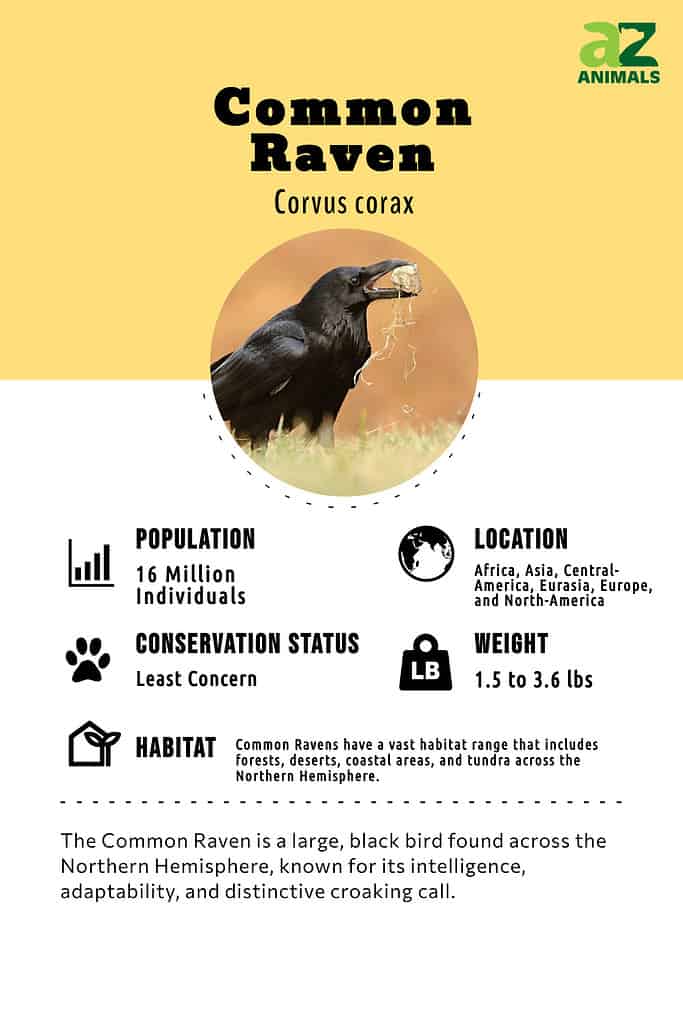
“The Common Raven is arguably the smartest bird of all!”
Common Raven Amazing Facts
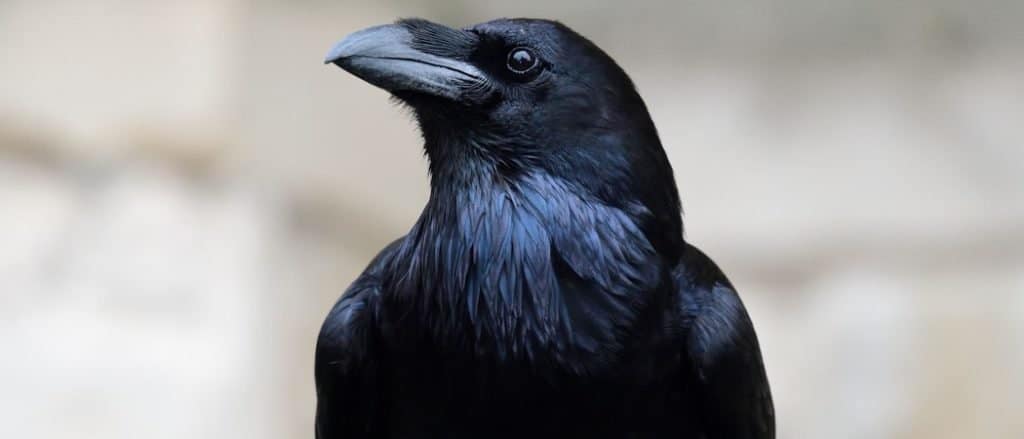
Close-up portrait of a Common Raven (Corvus corax)
©Tom Meaker/Shutterstock.com
- Ravens are extraordinarily intelligent, with brains larger than any other kind of bird. They are capable of solving complex problems and can even tell other ravens about events and objects that they can’t immediately see. They’ve even been known to notify wolves of carcasses so the wolves can open the carcass up for them.
- Ravens love to play, especially young Ravens. They will even play with members of other species such as dogs and even make toys to play with.
- As of 2021, seven ravens guard the Tower of London. It is believed that if the ravens ever left the Tower, the kingdom would collapse. There need to be six ravens guarding the Tower, with one as a spare just in case.
- Ravens are passerines or songbirds.
Where To Find Common Raven
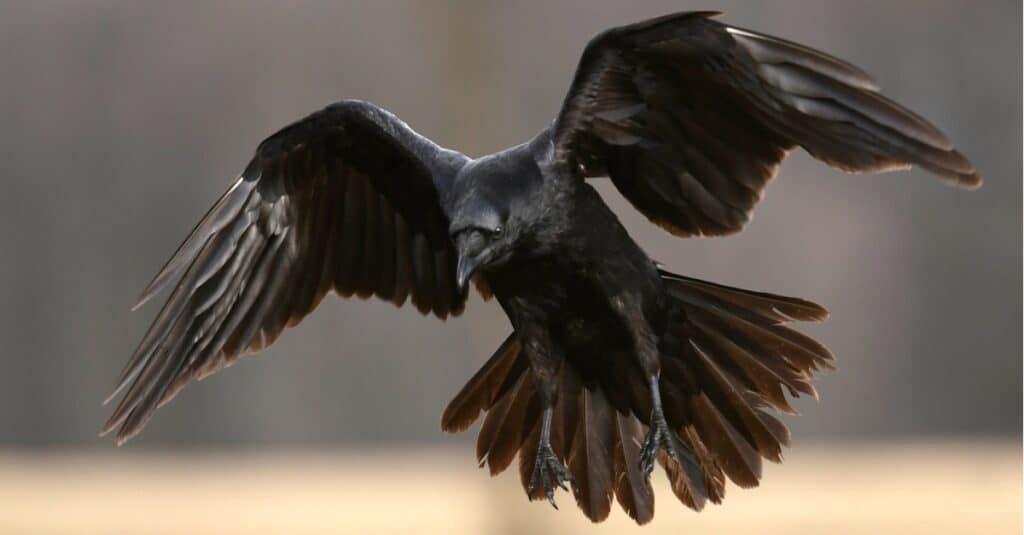
Corvids, such as ravens, are one of the few animals that use tools regularly to obtain food.
©iStock.com/Piotr Krzeslak
Ravens can be found in the northern hemisphere. They can be found in places where humans live, but not as plentifully as their cousin the crow. Ravens prefer wild, open spaces such as grassland, tundra, and somewhat open forests.
Scientific name
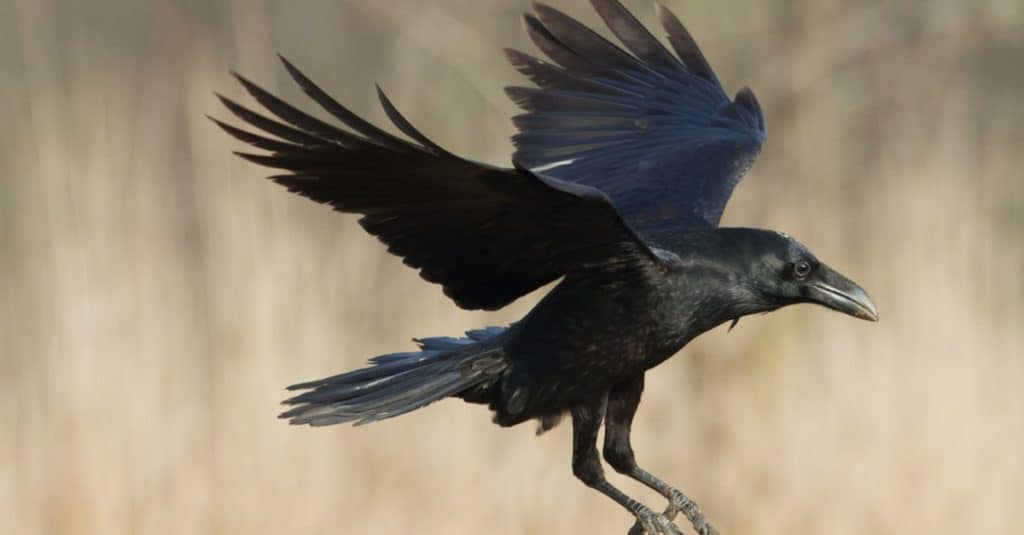
Common Raven (Corvus corax) flying over a field.
©Marcin Perkowski/Shutterstock.com
The scientific name of the common, or western raven is Corvus corax. “Corvus” comes from the Latin word for raven, and “corax” is a Latinized Greek word for “raven” or “crow,” so the bird can be thought of as a double crow.
Some biologists believe there are 11 subspecies of western raven while others believe there are only eight. They are:
- C. c. corax
- C. c. varius
- C. c. subcorax
- C. c. tingitanus
- C. c. tibetanus
- C. c. principalis
- C. c. kamtschaticus
- C. c. sinuatus
Evolution and Origins
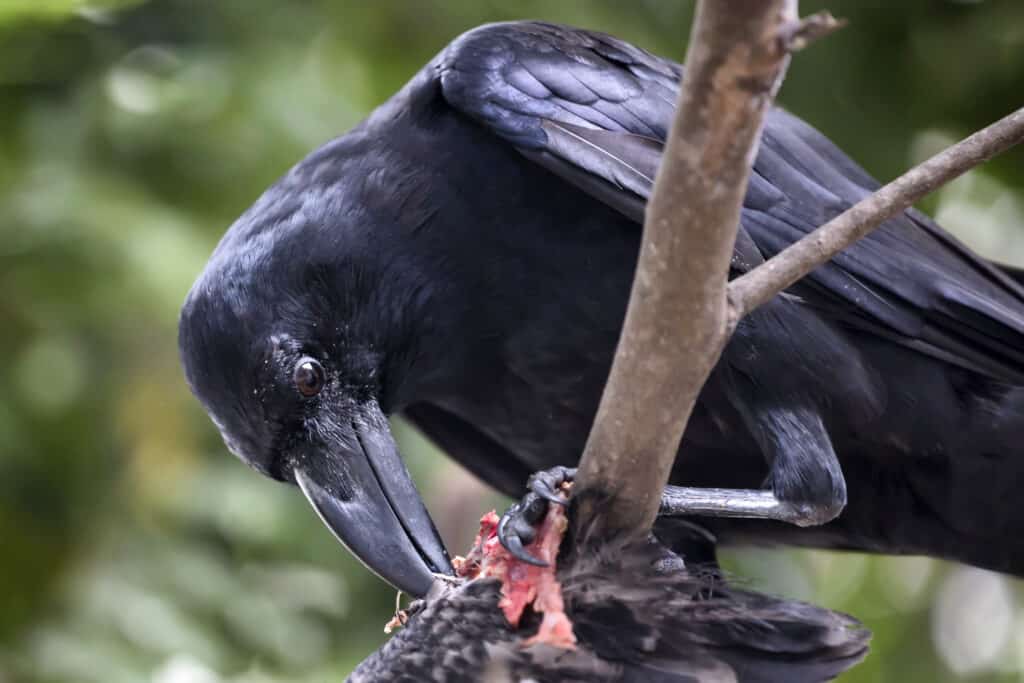
Raven eating carrion
©Raven eating carrion/Shutterstock.com
A possible reason for the genetic discoveries is that common ravens arrived in California around two million years ago and were isolated from their counterparts in Europe and Asia due to a period of glacial activity. A branch of the California group developed into a distinct species, known as the Chihuahuan raven, around one million years ago.
Approximately 1.5 million years ago, the birds in the present-day California region separated from the rest of the raven population, resembling a branch of a river that diverges from the main channel. Their continuous segregation enabled them to develop into a distinct species.
During the time of Greco-Roman antiquity, ravens had a significant role in Greek mythology, particularly with Apollo, the God of prophecy. The ravens were believed to represent misfortune and were considered divine messengers in the mortal realm. As per the myth, Apollo dispatched a white raven (or crow in other renditions) to monitor his beloved, Coronis.
Appearance
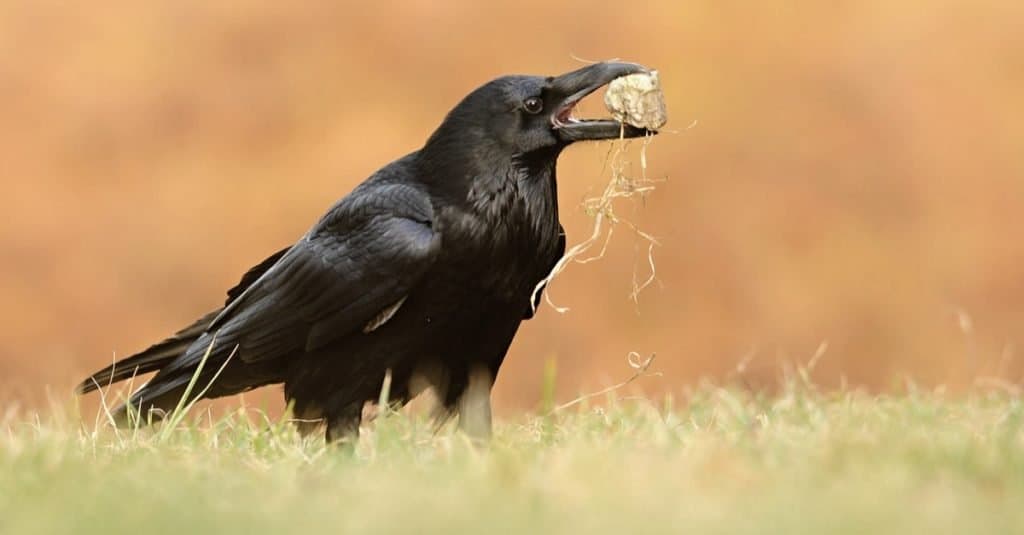
©Michal Pesata/Shutterstock.com
The raven is one of the largest passerine birds. Its feathers are glossy black and can show blue or purplish iridescence when a light shines on them. The length of the body is between 21 and 26 inches, and it has a thick, curved bill and a wingspan of around 4 feet. It can weigh close to 4 pounds. Females may be a bit smaller than males.
The tail is wedge-shaped, and the throat has feathers called hackles, which the bird can raise or lower to communicate. The shape of the tail, the hackles, the robustness of the bill and the size of the bird differentiates it from a crow. Also, ravens are more likely than crows to glide or soar in flight.
This unlikely songbird has a variety of vocalizations. Scientists have identified as many as 30 of them. Even their wingbeats have an evocative sound when the birds are in flight.
Behavior
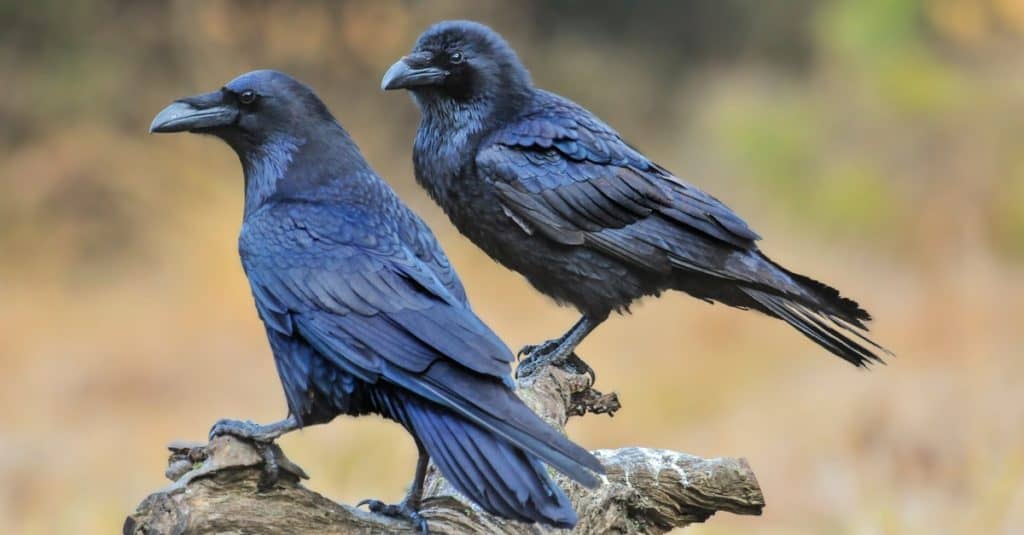
A pair of Common Raven on an old stump.
©Krasula/Shutterstock.com
Ravens are often solitary, but they sometimes travel with their mates and form flocks when they are young. Flocks, also called unkindnesses, may form when food is concentrated in an area. Young ravens seem to be fascinated with new objects, especially if they are bright and shiny. Older birds become more staid with age, even though they are better at problem-solving.
Common ravens don’t seem to migrate but may move around their range if the weather becomes too hot or too cold. A breeding pair is territorial and staunchly defends their young against would-be predators. They not only chase and scold potential threats but are clever enough to drop rocks on their heads if they come too close. Common ravens can also recognize individual ravens and even individual humans.
Check out this article to learn more about group raven names and how they function in flocks.
Diet
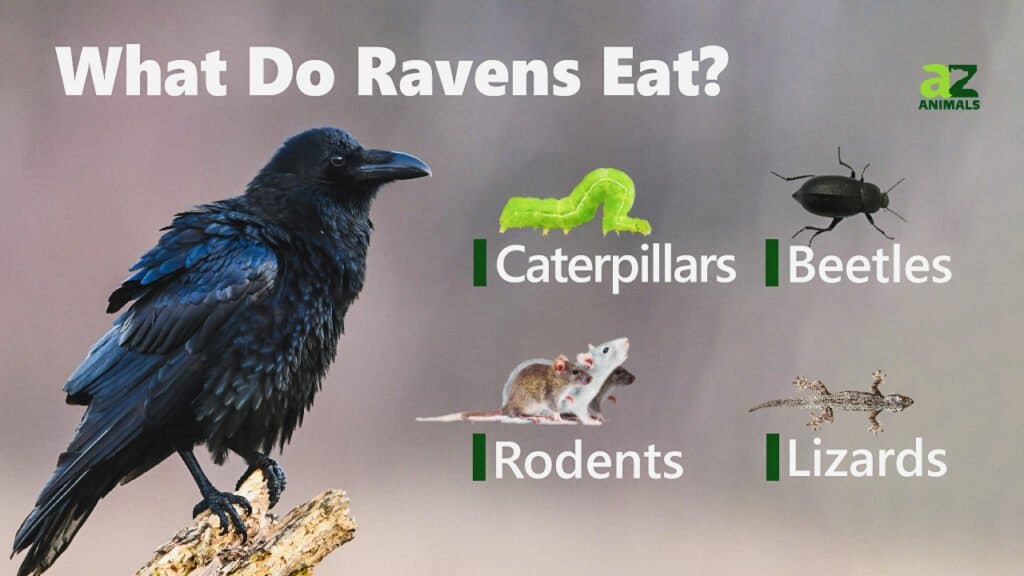
One of the things that makes the common raven so successful is that it is an omnivore and will eat just about anything that agrees with its digestive system. This includes both plant and animal material. They hunt small rodents, reptiles, amphibians, arthropods, and insects. They eat grain, fruit, and berries and can be pests to farmers. They scavenge and will not only eat carrion but the insects and insect larvae that are drawn to carrion.
They enthusiastically eat roadkill, and human garbage and will pick out the undigested food in feces. They raid the food caches of both ravens and other animals and hide that food in their own food caches. Common ravens eat the eggs and young of other birds and if the bird is small enough, it will eat the adult as well.
Ravens have been known to kill and eat newly born lambs, goats, and calves and don’t care if the animal is endangered. If a young raven finds a large carcass being enjoyed by adult ravens, it will call its friends to the food source.
But the common raven’s diet isn’t bottomless. Like other birds, chocolate is poisonous to it. Heavy metals such as lead and copper can make the raven sick. The seeds and pits of pears, apples, peaches, apricots, and related fruit are also not good for the bird, as they contain cyanide.
What does the common raven eat?
The common raven eats other animals, including mice, spiders, insects, reptiles, and amphibians. It eats human garbage, the undigested parts of animal droppings, and carrion. It will also eat plant material such as fruits, grains, and seeds.
Predators and Threats
This songbird is so big, intelligent, and vigilant that it is difficult for an animal predator to get the best of it. Yet owls and other birds of prey sometimes steal its eggs, as does the marten, a type of weasel. Sometimes a bird of prey will successfully attack an adult raven. These include bald and golden eagles, goshawks, great horned owls, eagle owls, and red-tailed hawks. Cougars, lynxes, and coyotes may also go after adult ravens, but this is unusual.
Reproduction, Babies, and Lifespan

©Wright Out There/Shutterstock.com
Ravens become mature when they’re about three years old, but they’ve been seen to court each other long before then. Ravens start to court in earnest in autumn and winter, with most eggs being laid in early spring depending on the birds’ range.
Scientists believe that pairs of ravens stay together at least during the breeding season, but they’re not sure if they mate for life. The court through performing acrobatics, showing off their intelligence, and showing a would-be mate that they’re good at finding food. When the female is ready to mate she crouches, drops and shakes her wings, and raises her tail.
The pair finds and defends a territory then builds the nest. It’s a deep but asymmetrical bowl of sticks and twigs lined with mud and tree bark and softened by materials such as fur. Nests are about 16 to 60 inches in diameter and 5 to 6 inches deep and placed in a big tree, at the edge of a cliff, in an abandoned building, or even on a telephone pole. Here, the female lays between three and seven eggs. They are pale blue-green and freckled with brown. The female incubates them for about 21 days. Only she incubates the eggs, but the male will protect the chicks by standing over them. Both parents feed the chicks. Ravens only have one brood per year.
The chicks fledge when they’re a little over a month old but can stay with their parents for half a year.
Common ravens can live a long time, and ravens at the Tower of London have lived over 40 years. Less pampered ravens live around 13 years in the wild.
Population
There are about 16 million common ravens in the wild, and their numbers seem to be increasing. Indeed, there are places where the raven’s numbers are exploding as landfills, highways, parks, and artificial bodies of water are set up to see to the needs of humans. There are areas such as Alaska where ravens need to be culled from time to time to protect vulnerable species.
View all 235 animals that start with CCommon Raven FAQs (Frequently Asked Questions)
Does the Common Raven migrate?
The common raven doesn’t really migrate but may move around its range to avoid harsh winters.
How many eggs does the Common Raven lay?
The common raven lays from three to seven eggs.
How fast does the Common Raven fly?
The common raven can fly 25 miles per hour, though a trained raven once flew at 40 miles per hour.
What is the Common Raven’s Wingspan?
The wingspan of this passerine is a little less than 4 feet across.
When do Common Ravens leave the nest?
Common ravens leave the nest when they are between five and seven weeks old.
Are ravens dangerous?
Ravens aren’t dangerous to humans, but a person should be careful of a nesting pair. They will defend their nest vigorously and have formidable claws and beaks.
What does a Common Raven eat?
Basically, a raven seems to eat anything it can digest, including animal and plant materials, garbage, and carrion.
What is the difference between a crow and a raven?
A raven is bigger than a crow, has a heavier beak, a wedge-shaped tail, and hackles on its neck. Its call is different from a crow’s and probably more varied, and it has a more graceful flight.
What is the raven a sign of?
In some cultures, the raven is a sign of death and bad fortune because of its inky black feathers and its habit of eating dead things. But in other cultures, the raven is a deity. Kutkh, or Kutcha, a raven god, was believed to have created the Kamchatka Peninsula.
Thank you for reading! Have some feedback for us? Contact the AZ Animals editorial team.
Sources
- The Guradian, Available here: https://www.theguardian.com/commentisfree/2017/aug/30/ravens-fly-fast-game-of-thrones
- Godchecker, Available here: https://www.godchecker.com/siberian-mythology/KUTKH/
- Wikipedia, Available here: https://en.wikipedia.org/wiki/Common_raven
- Bird life International, Available here: http://datazone.birdlife.org/species/factsheet/common-raven-corvus-corax/text
- Animal Diversity Web, Available here: https://animaldiversity.org/accounts/Corvus_corax/

















